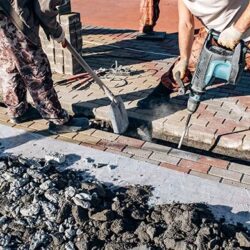Every structure, regardless of its size, requires a stable base. Without sufficient support, the walls of a building may crack, floors may move and the building may become unsafe!
This is why selecting the proper foundation system is so crucial. One of the best systems in modern construction is screw piers.
Screw piers are rapidly gaining popularity across Australia, being adopted for both residential housing projects and large commercial developments at an increasing rate. Their growth in usage is driven by a combination of strength, efficiency, and versatility, making them an attractive foundation solution for builders, engineers, and property owners alike. Unlike traditional concrete footings or other foundation methods, screw piers provide a durable and reliable alternative that can be installed quickly and with minimal site disruption.
One of the key advantages of screw piers is their load-bearing capacity. Designed to support a wide range of structures—from small residential decks and extensions to multi-storey commercial buildings—these piers can handle significant vertical and lateral loads. Their helical design allows them to be screwed deep into the ground, anchoring the structure securely and reducing the risk of settlement or movement over time. This makes them particularly valuable in areas with challenging soil conditions, such as clay-heavy sites, loose sand, or high water tables, where traditional foundations might struggle.
Another major benefit of screw piers is their speed and efficiency of installation. Because they are mechanically screwed into the ground rather than requiring large-scale excavation and curing like concrete footings, projects can progress much faster. This not only reduces labour costs but also minimizes disruption to the surrounding environment. In residential applications, homeowners can enjoy the convenience of a faster construction timeline with less mess and disturbance to their property. For commercial sites, this translates to improved project timelines and cost savings, which are critical in large-scale developments.
Screw piers are also highly versatile. They can be used for new constructions, additions to existing buildings, retaining walls, decks, and even for temporary structures that may need to be removed or relocated. Their modular nature allows for flexibility in design and load distribution, ensuring that a wide range of structural requirements can be met without the need for extensive customisation. Additionally, the fact that they can be installed year-round—regardless of weather conditions—adds another layer of practicality and reliability.
Environmental considerations further enhance the appeal of screw piers. Installation causes minimal ground disturbance, meaning less soil removal and reduced waste compared to traditional concrete foundations. This makes them a more sustainable choice, particularly for projects where preserving the natural landscape is important.
In summary, screw piers are emerging as a strong, reliable, and efficient foundation solution in Australia. Their ability to handle challenging soils, ease of installation, adaptability across multiple applications, and environmental benefits make them an increasingly preferred choice for both domestic and commercial projects. As the construction industry continues to evolve, screw piers are likely to play an even larger role in delivering safe, cost-effective, and long-lasting foundations across the country.
What Are Screw Piers?
Long steel posts with spirals (or blades) on the base (much like an enormous screw) are called screw piers. With the help of a specialised machine, they screw straight down to the required depth until they hit solid ground.
Due to the depth, and the method of connecting with the ground, screw piers are a very stable base in which to build off. If we think of screw piers like an anchor, we can visualise how much they help keep the structure stable, and not moving in varying circumstances.
Why Screw Piers Are Excellent for Residential Properties
When designing a new home, granny flat, or a new addition, screw piers can considerably ease the procedure. Here’s why:
Robust Support for New Homes
Houses constructed on screw piers usually have solid foundations. There will be less chance for problems such as sagging floors or cracks in the walls later.
Rapid Installation
When compared to concrete, which requires time to settle and cure, the advantage of screw piers is that they are immediately viable after being pressed into the ground. This makes home projects faster and less expensive.
Clean and Tidy Job
There is very little digging or soil removal on the site, so the process is cleaner. This is especially important when building in backyards or residential areas.
Suits all types of soil
Not all land is the same. Some blocks may contain clay, sand, or soft soil. Screw piers are stacked to work with most soils, and are an adaptable product for homeowners.
Why Screw Piers Are Ideal for Commercial Projects
When it comes to larger-scale developments like offices, storefronts, and warehouses, the structural and operational requirements often increase.
These types of structures are heavier, and these types of buildings are typically constructed in high-traffic areas. That’s why screw piers work very well for commercial projects.
Can Handle Large Loads
Screw piers are made from solid steel and can support the heavy weight of significant commercial structures without issues. This makes them dependable for long-term structural stability.
Keeps You On Track
Commercial developments usually have stricter timelines than residential builds. Screw piers are fast to install and don’t require several weeks to cure. This guarantees that projects remain on time and avoid costly delays.
Less Intrusive for Busy Areas
In a metropolitan or suburban setting, noise and vibrations can be an issue. Screw piers only have a minimal amount of disturbance during installation, with no ground vibrations or major noise, making them safer for nearby structural and utilities, as well as less intrusive to people in the surrounding area.
Additional Advantages of Using Screw Piers for Residential and Commercial Applications
Environmentally Friendly – Screw piers can be removed and reused, making them a more sustainable option than alternative solutions.
Cost-Effective – Less excavation, quicker installation, and fewer project delays often equate to overall savings.
Durable – Once in place, screw piers can provide reliable, long-term support.
In Conclusion
Screw piers are an excellent option for either residential or commercial operations. They are strong, they can be installed quickly with limited inconvenience to the surrounding environment, and they offer flexibility in developing many different types of buildings.
For homeowners, screw piers result in a safe, secure structure built on a long-lasting foundation. For commercial users, projects benefit from minimal delays to the development and the ability to accommodate large loads, while being less disruptive to communities longer-term.
In other words, screw piers are an intelligent, innovative, and dependable method for ensuring that a building’s construction stands on a secure and reliable foundation.




